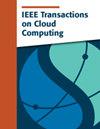IBNR-RD: Intra-Block Neighborhood Relationship-Based Resemblance Detection for High-Performance Multi-Node Post-Deduplication
IF 5
2区 计算机科学
Q1 COMPUTER SCIENCE, INFORMATION SYSTEMS
引用次数: 0
Abstract
Post-deduplication in traditional cloud environments primarily focuses on single-node, where delta compression is performed on the same deduplication node located on server side. However, with data explosion, the multi-node post-deduplication, also called global deduplication, has become a hot issue in research communities, which aims to simultaneously execute delta compression on data distributed across all nodes. Simply setting up single-node deduplication systems on multi-node environments would significantly affect storage utilization and incur secondary overhead from file migration. Nevertheless, existing global deduplication solutions suffer from lower data compression ratios and high computational overhead due to their resemblance detection's inherent limitations and overly coarse granularities. Similar blocks typically have high correlations between sub-blocks; inspired by this observation, we propose IBNR (Intra-Block Neighborhood Relationship-Based Resemblance Detection for High-Performance Multi-Node Post-Deduplication), which introduces a novel resemblance detection based on relationships between sub-blocks and determines the ownership of blocks in entry stage to achieve efficient global deduplication. Furthermore, the by-products of IBNR have shown powerful scalability by replacing internal resemblance detection scheme with existing solutions on practical workloads. Experimental results indicate that IBNR outperforms state-of-the-art solutions, achieving an average 1.99× data reduction ratio and varying degrees of improvement across other key metrics.IBNR-RD:基于块内邻域关系的高性能多节点重复数据删除后相似性检测
传统云环境中的重复数据删除后主要侧重于单节点,其中在位于服务器端的相同重复数据删除节点上执行增量压缩。然而,随着数据的爆炸式增长,多节点重复数据删除后(又称全局重复数据删除)已成为研究领域的热点问题,该技术旨在对分布在所有节点上的数据同时执行增量压缩。在多节点环境中简单地设置单节点重复数据删除系统会显著影响存储利用率,并导致文件迁移带来的次要开销。然而,现有的全局重复数据删除解决方案由于其相似性检测的固有局限性和过于粗糙的粒度,存在较低的数据压缩比和较高的计算开销。相似块通常在子块之间具有高相关性;受此启发,我们提出了基于块内邻域关系的高性能多节点重复数据删除后相似性检测(IBNR),该方法引入了一种基于子块之间关系的相似性检测方法,并在入口阶段确定块的所有权,以实现高效的全局重复数据删除。此外,在实际工作负载中,IBNR的副产品通过用现有的解决方案替代内部相似性检测方案,显示出强大的可扩展性。实验结果表明,IBNR优于最先进的解决方案,实现了平均1.99倍的数据缩减率,并在其他关键指标上有不同程度的改进。
本文章由计算机程序翻译,如有差异,请以英文原文为准。
求助全文
约1分钟内获得全文
求助全文
来源期刊

IEEE Transactions on Cloud Computing
Computer Science-Software
CiteScore
9.40
自引率
6.20%
发文量
167
期刊介绍:
The IEEE Transactions on Cloud Computing (TCC) is dedicated to the multidisciplinary field of cloud computing. It is committed to the publication of articles that present innovative research ideas, application results, and case studies in cloud computing, focusing on key technical issues related to theory, algorithms, systems, applications, and performance.
 求助内容:
求助内容: 应助结果提醒方式:
应助结果提醒方式:


